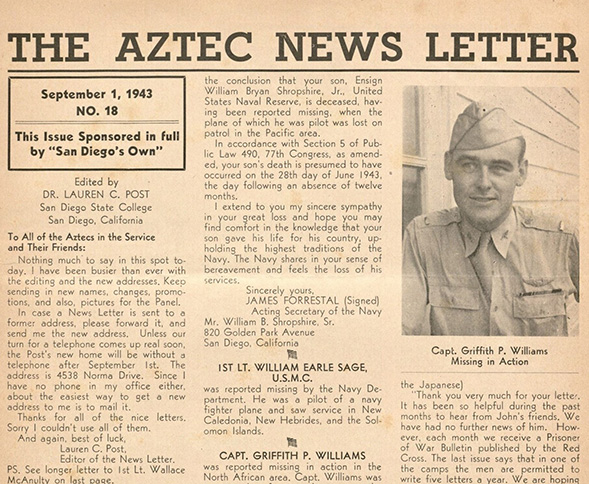SDSU History Comes to Life in Forgotten Fronts
The book gives new meaning to more than 4,000 letters from SDSU students and alumni serving in World War II.

“My hope is that when people read this book, they recognize we’re all in this together.”
“Dear Doc,” the letters begin, thousands of them written from San Diego State students and alumni scattered from Europe to Japan, North Africa and the South Pacific. They offer personal accounts of combat and valor, homesickness and the horrors of war.
Most of the writers had suspended their education—all had placed their personal lives on hold—to serve the nation during World War II. The recipient of their letters was Lauren Post, a fondly regarded geography professor at then-San Diego State College, who was a veteran of World War I.
As he received correspondence from all over the world, Post used the information to publish the Aztec News Letter, which at its height was sent to 3,000 Aztecs at home and abroad. With updates often uplifting and sometimes devastating, his publication was both eagerly and anxiously awaited by grateful young service members starved for news of friends and former San Diego State classmates.
The compelling contents of those letters and Post’s dedication to his students are the subject of a new book, “No Forgotten Fronts: From Classrooms to Combat,” by Lisa K. Shapiro. The author spent four years researching and writing the book, which has been released, fittingly, just in time for Memorial Day.
“This isn’t just history”
Those 4,848 letters comprise the World War II Servicemen's Correspondence Collection, 1941-1946, a one-of-a-kind compilation securely housed for almost 75 years in the SDSU Library’s Department of Special Collections and University Archives. That’s where Shapiro, a San Diego Mesa College assistant business professor, spent almost every free moment for two-and-a-half years reading the letters while researching a second master’s degree.
She completed the degree long before finishing the letters, but was compelled to keep reading.
“I just felt connected to those young men and women,” she said.
She was moved by the eloquence of their writing and the raw feelings they so honestly expressed. The letters, Shapiro said, reflect humor and gratitude, sadness and grief.
“What really made it personal for me was when I realized, okay, this isn’t just history; these were real lives and these are real emotions and these people sacrificed and struggled and they cared,” she explained. “I think it’s because their emotions come through so vividly in the letters.”
Finest hour
Shapiro is believed to be the only person since Post to have touched and completely read each individual letter. Although she could never have begun to cover all of the individuals and their letters in the book’s 25 chapters and 380 pages, the author has managed to include germane and poignant passages that successfully convey the war’s impact on its committed young combatants.
Rob Ray, director of the SDSU Library’s Special Collections and University Archives, came to know Shapiro during her research for the book.
“It’s so very well written and presented,” Ray said. “It’s absolutely a terrific story full of heroism, but also of great sadness.
“Her book, I think, really documents this as San Diego State’s finest hour when everyone was at their finest. It’s a moment in our history that should be remembered and celebrated.”
Hard to let go
Shapiro admits that one of the hardest things about completing her book was separating from its subjects. After she had finished her research, she would sometimes return to campus and visit the War Memorial where the names are etched of former students, including many of the letter writers, who went to war and never returned.
“I would go to the Memorial because I wanted to literally touch those names,” Shapiro said. “It was hard to let go. I guess that was my way of acknowledging them and saying goodbye, but even so, I still feel they are a part of me.”
Her reaction speaks to the unique nature of the collection. It is believed to be the only one of its kind with thousands of letters sent to a single person from hundreds of writers sharing their personal observations of the war.
Not forgotten
Of course, none of it would have been possible without the dedication and foresight of Post. Both Ray and Shapiro are effusive in their praise for the professor.
“I think she pays tribute and homage to Lauren Post in a way that we sometimes forget, that he is responsible for this,” Ray said. “He made it happen, and it was his constant coaching and encouragement and dedication to it, and he wouldn’t let it go.”
“I always say it would have been enough if he had just had people write to him and if he had just written back,” Shapiro observed. “But the fact that he did this newsletter for the duration of the war and let students know what all of their friends were doing and that he did it every single month—that’s the thing that sort of staggers the imagination.”
As a college instructor teaching veterans in her classroom, Shapiro looks to Post for inspiration.
“I don’t have any background with the military, but I think I have that connection with Dr. Post,” she said. “What are we going to do for those students and how are we going to help them transition?”
A changed perspective
Shapiro hopes her book inspires others to follow Post’s example. More importantly, she hopes it can provide some insight into young people committed to military service.
“The thing about that book that changed my perspective of service and war—and I think the people in the military get this and sometimes other civilians don’t—is how willing young men and women are to sacrifice and what that means and how seriously we should take that,” Shapiro explained. “My hope is that when people read this book, they recognize we’re all in this together. I want people to feel that more intimately and feel more personally how we are all changed by war. It’s incumbent upon all of us to appreciate the impact.”
“No Forgotten Fronts: From Classrooms to Combat” is available at the SDSU Bookstore and through shopaztecs.com.



